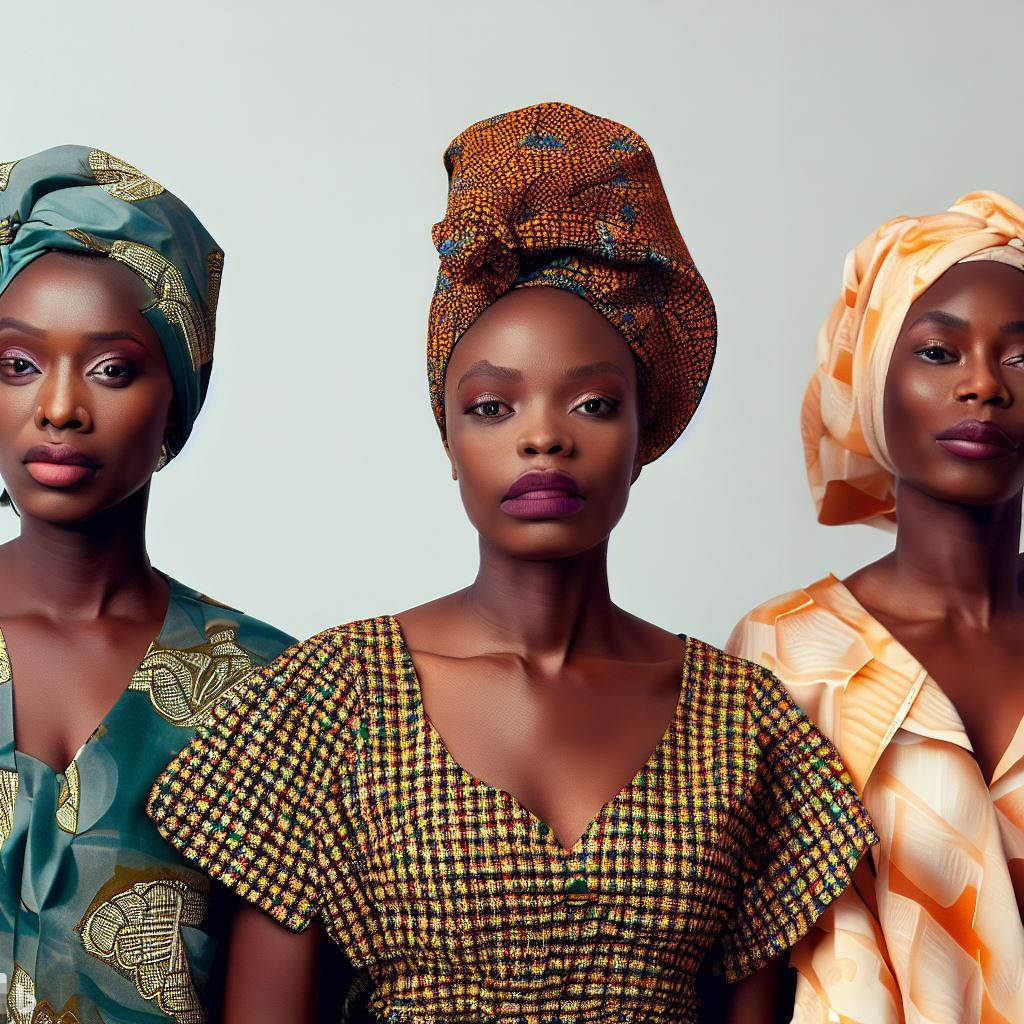Introduction
The fashion industry in Nigeria has witnessed a remarkable transformation over the years.
From traditional attire to contemporary fashion, Nigeria has become a hub for innovative and unique designs.
Technology has played a vital role in this evolution, revolutionizing the way fashion designers operate.
The use of technology in fashion design has significantly improved the efficiency and productivity of designers.
With the introduction of computer-aided design (CAD) software, designers can quickly create and modify designs, minimizing the time and effort required.
This has enabled Nigerian designers to keep up with global trends and compete on an international level.
Moreover, technology has also opened up new avenues for creativity in fashion design.
With digital printing and 3D modeling, designers can experiment with textures, patterns, and colors like never before.
This has allowed for the creation of unique and unconventional designs that cater to the diverse tastes and preferences of Nigerian consumers.
Furthermore, technology has revolutionized the marketing and distribution of fashion products.
With the rise of e-commerce platforms, Nigerian designers can reach a global audience without the limitations of physical stores.
Social media platforms have also become instrumental in promoting and showcasing Nigerian fashion to the world.
Basically, fashion design technology has become an integral part of the Nigerian fashion industry.
It has not only enhanced the efficiency and creativity of designers but also boosted the country’s reputation in the global fashion scene.
This blog post will delve deeper into the specific technologies and their impact on Nigerian fashion design. Stay tuned for an in-depth exploration of fashion design technology in Nigeria.
Historical background of fashion design in Nigeria
Traditional Nigerian fashion and textiles
Nigeria is rich in cultural diversity, with over 250 ethnic groups, each having their unique traditional costumes and textiles.
These traditional outfits are not only a representation of identity but also a source of inspiration for contemporary fashion designers.
Traditional Nigerian fashion is characterized by vibrant colors, intricate patterns, and rich fabrics such as the popular Aso Oke, Adire, and Ankara.
These textiles are handwoven or dyed using traditional techniques passed down through generations.
The fashion industry in Nigeria has always been deeply rooted in these traditional textiles and techniques, forming the foundation for its evolution.
Influence of Western fashion on Nigerian designs
With the arrival of Europeans in Nigeria, Western fashion started to impact the country’s sartorial choices.
Colonialism introduced new fabrics like lace and satin which were incorporated into traditional attire.
Post-independence, globalization further accelerated the influence of Western fashion on Nigerian designs.
The exposure to international fashion through media and travel opened up new possibilities for fashion designers.
Designers began to blend traditional and Western elements, creating a unique fusion of styles.
This fusion allowed Nigerian fashion to stand out globally, drawing attention to its vibrant, eclectic, and innovative designs.
Emergence of local fashion designers
In the early 1960s, Nigeria witnessed a surge in the emergence of local fashion designers.
These designers showcased their talents through fashion shows, which became an avenue for promoting Nigerian fashion.
One of the pioneers, Mrs. Folake Solanke, established the Nigerian Fashion Designers Association (NFDA) in 1963.
This association aimed to promote Nigerian fashion and provide a platform for designers to collaborate and exchange ideas.
Over the years, Nigerian fashion designers gained recognition both locally and internationally.
They started participating in renowned fashion weeks, such as Lagos Fashion Week, showcasing their creativity and talent to a wider audience.
The emergence of local fashion designers not only contributed to the growth of the fashion industry but also played a significant role in showcasing Nigeria’s cultural heritage and promoting economic development.
Read: How to Start an Interior Design Business in Nigeria
Evolution of technology in Nigerian fashion design
Introduction of sewing machines and its impact
- Sewing machines revolutionized the Nigerian fashion industry, increasing production efficiency and quality.
- The introduction of sewing machines enabled fashion designers to create garments more quickly and accurately.
- These machines allowed for the mass production of clothing, leading to a more accessible fashion market.
- Designers could now experiment with different designs and patterns, expanding the variety of Nigerian fashion.
- The use of sewing machines also created employment opportunities, contributing to the growth of the fashion industry.
The role of computers and software in fashion design
- The adoption of computers and specialized software has transformed the way Nigerian fashion designers work.
- Computer-aided design (CAD) software allows designers to create digital sketches, eliminating the need for manual drawings.
- CAD software also enables designers to visualize their creations in 3D, facilitating better communication with clients and manufacturers.
- Computerized pattern-making software has made it easier and more efficient to develop garment patterns.
- These advancements in technology have increased precision, reduced errors, and accelerated the design process.
Advancements in digital printing technology
- Digital printing has revolutionized textile design in Nigeria by offering more possibilities and customization options.
- Traditional printing methods required a time-consuming and labor-intensive process, limiting design choices and scalability.
- Digital printing allows for the reproduction of intricate patterns and vibrant colors on various fabrics.
- Designers can now experiment with different prints and patterns without the need for expensive setup costs.
- This technology has opened up new opportunities for Nigerian designers to showcase their creativity and attract a global market.
Integration of social media and e-commerce platforms
- The rise of social media and e-commerce platforms has transformed the marketing and distribution of Nigerian fashion.
- Fashion designers can now showcase their collections to a wider audience through platforms like Instagram and Facebook.
- Social media platforms also allow designers to receive instant feedback and engage with their customers directly.
- E-commerce platforms provide Nigerian fashion designers with the opportunity to sell their products globally.
- Online marketplaces and websites enable designers to reach customers who wouldn’t have access to their physical stores.
- This integration of technology has promoted the growth of the Nigerian fashion industry and boosted its international visibility.
Read: The Importance of Continuing Education for Designers in Nigeria
Innovative applications of technology in Nigerian fashion design
Use of 3D printing in fashion prototypes and accessories
- The fashion industry in Nigeria has embraced the use of 3D printing technology.
- Designers are using 3D printing to create unique and intricate fashion prototypes.
- This technology allows for the production of complex designs that traditional methods cannot achieve.
- 3D printed accessories, such as jewelry and shoes, are becoming popular in the Nigerian fashion scene.
- Designers are able to experiment with different materials and textures using 3D printing.
- The use of 3D printing has also reduced the lead time for producing fashion prototypes, making the design process more efficient.
Virtual reality and augmented reality experiences in fashion design
- Virtual reality (VR) and augmented reality (AR) are revolutionizing the way fashion designs are presented.
- Designers can create immersive VR experiences to showcase their collections.
- AR allows customers to try on virtual outfits and accessories before making a purchase.
- This technology enhances the shopping experience and helps customers make informed decisions.
- Virtual fashion shows have also become popular, allowing designers to showcase their collections to a global audience.
- VR and AR are bridging the gap between the physical and digital worlds, transforming the fashion industry in Nigeria.
Sustainable and eco-friendly practices through technology
- Technology is playing a crucial role in promoting sustainable and eco-friendly practices in Nigerian fashion.
- Designers are using innovative materials made from recycled or organic sources.
- Digital fabric printing reduces water and chemical waste compared to traditional printing methods.
- Advanced manufacturing technologies enable the creation of zero-waste patterns, minimizing fabric waste.
- Fashion brands are adopting supply chain management systems that track and reduce carbon emissions.
- By leveraging technology, Nigerian fashion designers are striving to create a more sustainable industry.
Digital pattern-making and automated garment production
- Digital pattern-making software has made the process of creating patterns more precise and efficient.
- Designers can now digitize their patterns and make adjustments with ease.
- This technology also allows for customization, as patterns can be easily modified to fit individual measurements.
- Automated garment production, such as computerized cutting and sewing machines, has increased productivity.
- These technologies streamline the production process, reducing human error and labor costs.
- Nigerian fashion designers are embracing digital pattern-making and automation to stay competitive in the industry.
Read: Understanding Client Needs: A Guide for Nigerian Designers

Obstacles and challenges of implementing fashion design technology in Nigeria
Limited access to technology and internet infrastructure
- Nigeria faces challenges in providing widespread access to technology and internet infrastructure, limiting the use of fashion design technology.
- The lack of reliable internet connections in many parts of the country hinders designers from utilizing online platforms.
- Without access to technology, designers struggle to stay updated on the latest fashion design trends and techniques.
Financial constraints for small-scale designers:
- Many fashion designers in Nigeria operate on a small-scale and face financial constraints in investing in expensive design technology.
- The cost of purchasing design software, equipment, and machinery becomes a significant obstacle for designers.
- Without adequate financial resources, designers find it challenging to compete in the rapidly evolving fashion industry.
Lack of awareness and educational opportunities
- There is a limited awareness and understanding of the benefits and potential of fashion design technology among designers in Nigeria.
- Due to this lack of awareness, many designers are reluctant to adopt new technologies and processes in their design practices.
- The absence of educational programs and training opportunities specific to fashion design technology further hampers its implementation.
The obstacles and challenges faced in implementing fashion design technology in Nigeria hinder the growth and development of the industry.
However, with concerted efforts and support, these challenges can be overcome.
Steps such as:
- Strengthening the technology and internet infrastructure in Nigeria to enhance access and connectivity.
- Providing financial support, grants, and loans to small-scale designers to invest in fashion design technology.
- Creating awareness campaigns and educational programs to educate designers about the benefits of technology adoption.
By implementing these measures, Nigeria can bridge the gap and enable the successful implementation of fashion design technology.
The use of technology in fashion design can revolutionize the industry, optimizing design processes, enhancing creativity, and expanding market opportunities.
Additionally, it can contribute to the economic growth of the country by creating employment opportunities and attracting investments in the fashion sector.
Therefore, it is crucial for Nigeria to address the obstacles and challenges hindering the implementation of fashion design technology and pave the way for a more technologically advanced and competitive fashion industry.
Read: Networking in the Nigerian Interior Design Industry: Tips
Impact of Fashion Design Technology on the Nigerian Fashion Industry
Increased efficiency and productivity in design processes
- Fashion design technology has streamlined the design process, reducing manual labor and saving time.
- Designers can now create digital sketches, patterns, and prototypes with ease, increasing their productivity.
- Technology allows for faster communication and collaboration between designers, manufacturers, and suppliers.
- Efficiency in production has improved, leading to a faster turnaround time for fashion collections to reach the market.
Expansion of opportunities for designers and entrepreneurs
- Technology has opened up new avenues for Nigerian designers and entrepreneurs to showcase their talent.
- Online platforms and social media have provided a global stage for Nigerian fashion, reaching a wider audience.
- E-commerce platforms have enabled designers to sell their products directly to consumers, bypassing traditional retail channels.
- Access to international markets has become easier, allowing Nigerian fashion brands to expand their reach and grow their businesses.
Enhanced creativity and innovation in design concepts
- Fashion design technology has fueled the creativity of Nigerian designers, allowing them to experiment with new ideas.
- Digitization of design processes has removed limitations, enabling designers to explore unconventional styles and techniques.
- CAD (Computer-Aided Design) software has revolutionized pattern-making, giving designers the freedom to create intricate and complex designs.
- Technology has made it possible to incorporate innovative materials and technologies into fashion, pushing the boundaries of design.
Global recognition and competitiveness of Nigerian fashion
- Fashion design technology has elevated the reputation of Nigerian fashion on the global stage.
- Nigerian designers have gained recognition for their unique blend of traditional African aesthetics with modern design sensibilities.
- Technology has enabled Nigerian fashion to compete with international brands, showcasing the country’s rich cultural heritage.
- The use of technology in design and production has improved the quality of Nigerian fashion, making it globally competitive.
Generally, the impact of fashion design technology on the Nigerian fashion industry has been significant.
It has brought increased efficiency and productivity in design processes, expanded opportunities for designers and entrepreneurs, enhanced creativity and innovation in design concepts, and elevated the global recognition and competitiveness of Nigerian fashion.
As technology continues to advance, it is expected to further transform the Nigerian fashion industry, opening up new possibilities for growth and success.
Future prospects and trends in fashion design technology in Nigeria
Predictions for upcoming technological advancements
- Integration of artificial intelligence (AI) in fashion design software to streamline the design process.
- Advancements in 3D printing technology to enable the creation of intricate and customizable fashion pieces.
- Implementation of augmented reality (AR) technology to enhance the shopping experience for customers.
- Use of smart fabrics and wearable technology to create interactive and multifunctional clothing.
Growing demand for sustainable and ethical fashion practices
- Increased consumer awareness about the environmental impact of the fashion industry is driving the demand for sustainable and ethical practices.
- Adoption of eco-friendly materials, such as organic cotton and recycled fabrics, to reduce waste and promote sustainable production.
- Emphasis on fair trade practices and transparent supply chains to ensure ethical sourcing and manufacturing processes.
- Rise of slow fashion movement, promoting quality over quantity and encouraging conscious consumption.
Importance of continuous learning and adaptation to new technologies
- Fashion designers need to embrace continuous learning to stay updated with the latest technological advancements.
- Regular training and workshops on new software and design tools will enable designers to enhance their skills and creativity.
- Collaboration with technology experts and researchers can help fashion designers explore innovative solutions and push boundaries.
- Being adaptable to new technologies allows designers to improve efficiency, productivity, and overall design quality.
Essentially, the future of fashion design technology in Nigeria looks promising with upcoming advancements, growing demand for sustainable practices, and the importance of continuous learning and adaptation.
Incorporating AI, 3D printing, AR, and smart fabrics will revolutionize the industry, offering unique and interactive fashion experiences.
Additionally, embracing sustainability and ethical practices will not only fulfill consumer demands but also contribute to a greener and socially responsible fashion industry.
Fashion designers who continuously learn and adapt to new technologies will thrive in this rapidly evolving landscape.
It is crucial to embrace change and seek collaboration to ensure Nigeria’s fashion design technology remains at the forefront of innovation and creativity.
Conclusion
Recap of the significance of technology in Nigerian fashion design
Technology has revolutionized the Nigerian fashion design industry, accelerating growth, fostering innovation, and expanding market opportunities.
From 3D printing to virtual reality, technology has transformed the way designers create and present their collections, providing them with a competitive edge.
Encouragement for further exploration and adoption of technology in the industry
As the Nigerian fashion design industry continues to evolve, it is crucial for designers, brands, and fashion institutions to embrace and fully explore the potential of technology.
Investing in technological advancements such as automation, digital pattern-making, and sustainable production methods will enhance efficiency and drive sustainable growth in the sector.
Final thoughts on the future of fashion design technology in Nigeria
The future of fashion design technology in Nigeria looks incredibly promising.
With the rapid advancement of technology globally, the Nigerian fashion industry has the opportunity to bridge the gap and position itself as a leader in fashion design innovation.
By harnessing the power of technology, designers can expand their reach, streamline production processes, and create sustainable and ethical fashion that meets the demands of the modern consumer.




